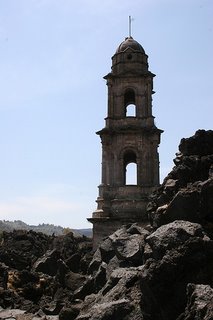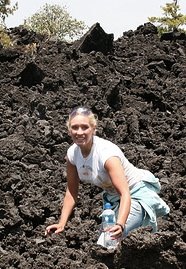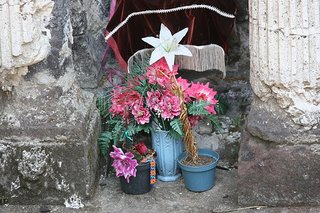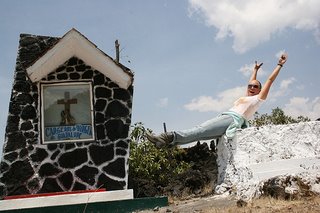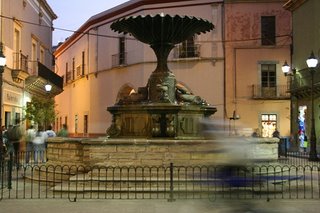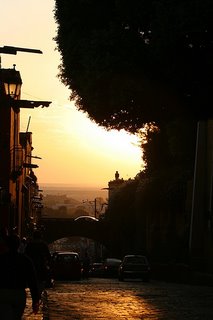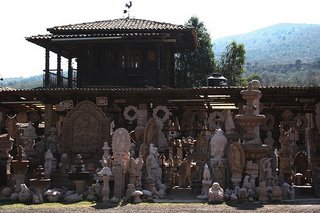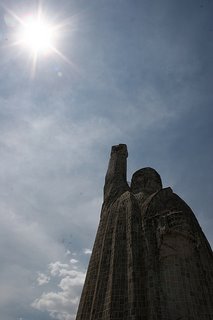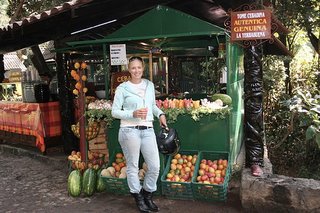Back to the beach, back to the basics.
 I love the mountains. I do. I love mountains and colonial cities and volcanoes (theoretically), but having been raised in, on and around water, I go a little crazy if I’m landlocked for too long. After a lengthy trek through the hinterlands, I was starting to feel like the goldfish who quit the bowl (and found himself belly-up on the kitchen floor. Even the motorcycle looked like it could use a good drink from the stream). So a few weeks ago I said goodbye to inland Mexico and followed the free highway back to the coast.
I love the mountains. I do. I love mountains and colonial cities and volcanoes (theoretically), but having been raised in, on and around water, I go a little crazy if I’m landlocked for too long. After a lengthy trek through the hinterlands, I was starting to feel like the goldfish who quit the bowl (and found himself belly-up on the kitchen floor. Even the motorcycle looked like it could use a good drink from the stream). So a few weeks ago I said goodbye to inland Mexico and followed the free highway back to the coast.There’s something that changes inside you when you go to the ocean… Similarly, there’s something that changes inside you when you realize you’ve been traveling for ten months. I don’t know which it was exactly, but as soon as I was in Playa Azul breathing salt air and dumping sand out of my boots again I had an overwhelming Buddhist zen-like urge for everything around me to be very simple. With the bike, I’m often so entranced by the sun and the sky and the wind and the ground passing under me, that when I snap out of this spell, it’s hard to remember why it is I need… well… anything, other than maybe a few clothes and some gas money.
So in one of these instants I decided to dump half my luggage – out went chain lube, bike cleaner, rain gear, most of the medicine kit, books, vitamins, plastic silverware, clothes, an unused repair manual, a hat, some wrenches too small to be practical and a random pair of cooking tongs. (Some might call such a massive discharge foolish – “You’ll be sorry,” they say, “when you find yourself in a rut without any gear.” Might I remind these skeptics that Mexico is not Botswana. Anything I need I can buy in a store.) If you’ve never thrown out a whole bunch of stuff in a half-delusional whim, you’ve missed out on one of the finer pleasures in life.
I replaced 30 pounds of luggage with a new bikini and a pair of flip-flops and found myself a space under an oceanfront palapa where I parked my tent for a few days (cost: $2.00 per night). I meandered in this fashion along the coast, passing through Playa Azul, Zihuatanejo, Pie de la Cuesta and Pinotepa National. A newfound proficiency in Spanish opened the door to a whole new world of colorful conversation, and at night I would often find myself sitting across from a new Mexican friend animatedly recounting the story of his life. I heard it all, from the tragic (alcoholism, jail, murders, lost children, drug overdoses) to the… actually, for a while there it was mostly tragic – but it kept me hanging off the edge of my seat. (Some interesting stuff concerning local culture and history always made it into the mix too).
One day on the coastal route, I noticed my hands were suddenly covered with strange, solar-induced bumps… to remedy this lizard-skin malady (no amount of SPF seemed to work, and my riding gloves were long ago lost), I started wrapping them in shards of an old t-shirt that had been torn and torn again and used as a towel, a head wrap, a motorcycle chain cleaning cloth, and most recently emergency clean-up relief when I dumped a bottle of fuchsia nail polish. (It’s that old anomaly – no matter with what packaged products and supplies I prepare myself, a shredded t-shirt is my most revered possession… which is why I no longer have packaged products, only scraps). I was able to creatively wrap to conceal the nail polish on one rag, but the other was hopelessly covered. So with my grease-stained, faux blood-tainted rags, I looked like some sort of rough rider who just stepped out of a bar fight (with a George Thorogood song playing in the background). The boldest of military checkpoint inspectors and gas station attendants would sometimes ask what happened to my hands. “Nothing,” I’d reply. Then I’d smile sweetly, bat my eyelashes, and drive away. (My hands have since recovered).
 It would be silly to try and describe entire trek along the coast. Suffice it to say that one fine day I arrived in Puerto Escondido. There are places where nature enchants you and there are places where the people enchant you, and then there are places where some otherworldly force is at work and it grabs hold of you and won’t let go … Puerto Escondido is all of this. Any real surfer from any country will tell you he/she has heard of Puerto, but it seems the town itself has no idea it’s been discovered by the entire world – as if its only ambition is to be like your friend’s basement in high school. Except that this time instead of ungainly teenagers, Boone’s Farm and bowling trophies, you’ve got charismatic travelers, eye-catching surfers, Mexican beer and miles of big, beautiful beach.
It would be silly to try and describe entire trek along the coast. Suffice it to say that one fine day I arrived in Puerto Escondido. There are places where nature enchants you and there are places where the people enchant you, and then there are places where some otherworldly force is at work and it grabs hold of you and won’t let go … Puerto Escondido is all of this. Any real surfer from any country will tell you he/she has heard of Puerto, but it seems the town itself has no idea it’s been discovered by the entire world – as if its only ambition is to be like your friend’s basement in high school. Except that this time instead of ungainly teenagers, Boone’s Farm and bowling trophies, you’ve got charismatic travelers, eye-catching surfers, Mexican beer and miles of big, beautiful beach. On the first day, I happened upon a place called Surf Hostel Zicatela. A dark cement stairwell next to a cinema-slash-café-slash-surfboard rental shop led to an uninviting black door where a black iron bell (an actual bell, like one you clang) was the only means of entry. From this shady entryway, I stepped across some sort of magic threshold (like when Dorothy lands and discovers Technicolor) into an open-air balcony where a thatched roof was draped over a beehive of board shorts, bikini tops and flip-flops. Sun-streaked dreadlocks and ponytails fell loosely down browned backs; old surfboards were crammed into corners and hammocks of various colors and sizes were weighted down with relaxed, outstretched bodies. Some people stood cooking cheap noodles on the rusted camping stove; others dabbled nonchalantly with the music on the portable stereo. The single dorm room was crammed with maybe 25 sets of bunked beds with flimsy foam cushions in the place of mattresses, and backpacks, sleeping bags and drying towels were thrown everywhere. In short, this was a traveler’s paradise.
On the first day, I happened upon a place called Surf Hostel Zicatela. A dark cement stairwell next to a cinema-slash-café-slash-surfboard rental shop led to an uninviting black door where a black iron bell (an actual bell, like one you clang) was the only means of entry. From this shady entryway, I stepped across some sort of magic threshold (like when Dorothy lands and discovers Technicolor) into an open-air balcony where a thatched roof was draped over a beehive of board shorts, bikini tops and flip-flops. Sun-streaked dreadlocks and ponytails fell loosely down browned backs; old surfboards were crammed into corners and hammocks of various colors and sizes were weighted down with relaxed, outstretched bodies. Some people stood cooking cheap noodles on the rusted camping stove; others dabbled nonchalantly with the music on the portable stereo. The single dorm room was crammed with maybe 25 sets of bunked beds with flimsy foam cushions in the place of mattresses, and backpacks, sleeping bags and drying towels were thrown everywhere. In short, this was a traveler’s paradise. This was also a place that would later be described by one of its longer-term residents as a “crazy house”. And that it was. You could not dream up a nuttier cast of characters. There was “El Flaco”, a well-meaning, rail-thin Mexican I only once saw wearing shoes and who one night performed some sort of tribal hand-reading on me (then recoiled in horror, and went to smoke a cigarette without much explanation). There was the animated Sebastian from Argentina who was always belting out some Spanish tune and making jewelry from seeds he trekked five days through the rainforest to collect (he also told a sidesplitting story of his wine-drinking pet birds named Doobie and Pepe, but it’s probably only funny if you were there). There was a band of four – an Austrian, a Canadian, a Mexican and an enormously tall Swede – who would play poker at the old wooden table in the middle of the room until all hours of the morning and the Austrian would claim he sold his girlfriend for a 20 peso buy-in. And there was Lou, a good-hearted yet totally bizarre character who spoke a strange hybrid of Spanish and British English – neither of which were totally intelligible. One morning when I was heading out to surf he jostled awake and tiredly asked me, “Where do you live?” He had already asked me where I was from the night before.
This was also a place that would later be described by one of its longer-term residents as a “crazy house”. And that it was. You could not dream up a nuttier cast of characters. There was “El Flaco”, a well-meaning, rail-thin Mexican I only once saw wearing shoes and who one night performed some sort of tribal hand-reading on me (then recoiled in horror, and went to smoke a cigarette without much explanation). There was the animated Sebastian from Argentina who was always belting out some Spanish tune and making jewelry from seeds he trekked five days through the rainforest to collect (he also told a sidesplitting story of his wine-drinking pet birds named Doobie and Pepe, but it’s probably only funny if you were there). There was a band of four – an Austrian, a Canadian, a Mexican and an enormously tall Swede – who would play poker at the old wooden table in the middle of the room until all hours of the morning and the Austrian would claim he sold his girlfriend for a 20 peso buy-in. And there was Lou, a good-hearted yet totally bizarre character who spoke a strange hybrid of Spanish and British English – neither of which were totally intelligible. One morning when I was heading out to surf he jostled awake and tiredly asked me, “Where do you live?” He had already asked me where I was from the night before.“New York”.
“Yes, yes, I know, but where do you live now?”
“Now? I’m just traveling, so I stay in different places…”
“Yes, right, but at this very moment, where do you live?”
“Umm… at this hostel?”
“Yes yes, but I mean, where is this hostel?”
“…Puerto Escondido?”
“Ah, yes, right, right, splendid.”
Then fell back to sleep, spread eagle on his foam mattress. I could go on for pages with stories like these. But I’ll move on…
Within my first few hours in Puerto Escondido, I’d found one of the red-shorted lifeguards to teach me how to surf. The next morning as the sky was just starting to color, I piled onto a four-wheeler with three lifeguards and a surfboard and we sped a few kilometers down the beach to where the morning haze met a rocky outcropping. Surfers and fishermen exchanged muted greetings, some sorted out their nets and others waxed boards, and some stood in silent veneration of the rolling waves and foaming waters at their feet. It felt like I’d just been let in on a big secret (and as payment surrendered another piece of sanity to the madness of the sea... sanity is in ever-diminishing supply on this trip).
Learning how to surf is like learning how to ski or to ride a motorcycle – the second you stand up and are carried over top of the water, you start mentally re-working your life plans. With my surf instructor (Jorge), we paddled out and practiced sitting on the board, laying on the board, rolling over the waves, and waiting waiting waiting for the just the right moment… Jorge’s favorite English phrase was “Take it easy, take it easy,” which he would use so often you would have thought I was fighting my way out of a straight jacket. Sometimes when we were in the wrong spot at the wrong time, he would swipe me off the board and under the rolling wave, and then I’d feel myself dragged beach-ward by the strap attached to my ankle. (It gives you a whole new respect for the ocean). Then I’d reconnect with the board and paddle back out, and once I was back on the board I’d hear, “Take it easy, take it easy”. It was funny, amazing, exhilarating. And I did it, I surfed. I found my waves and I surfed.

So the ecstasy of Puerto Escondido behind, I've now headed back inland and am traveling with only two very modest saddle-bags (my compacted leather jacket fills ¼ of the space), a tent, a sleeping bag, and my camera equipment (and an Italian girl named Anna, with whom my only shared language is Spanish… but more on that later). The lone remainders of my once smartly-assembled riding wardrobe are a pair of dirty jeans, a trusted collection of thinning t-shirts, and my cowboy boots. I’ve become an expert at washing clothes in public restrooms and my hair looks like I was raised by a pack of sun-loving wolves.
And with this simplicity, I’ve found some sort of basic, perfect happiness. Things are as they should be.
